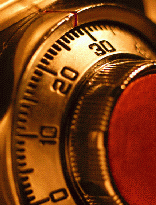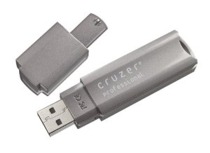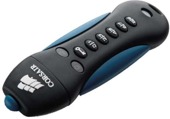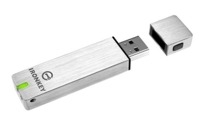|
 USB flash drive and security - How to protect the contents of a USB stickA USB flash drive (USB stick) is very useful when data needs to be transported from one place to another. A USB flash drive is lightweight and small in size and can for example be stored in a pocket or in a wallet. You can also store large amounts of data on USB flash drives, in some sticks up to 64 GB, so if you need to transport lots of data, using a USB stick can be very convenient. Security risks USB flash drives are useful, but there are some security risks to consider when carrying a USB flash drive – it can be lost or stolen. This is really of great concern if the drive contains sensitive information, for example financial information, business plans, source code for software, employee data, technical drawings etc. To prevent that the information may end up in the wrong hands there are USB flash drives available that can protect the data that is stored on the drive. The data will be stored encrypted and nobody can access the data without correct password, pin code, fingerprint or other authentication information. Examples of USB flash drives (USB sticks) that can protect data Below we will give some examples of USB flash drives where security has been in focus when they were constructed. They use all a hardware based system to protect the contents of the drive.
There are more USB flash drives available on the market that can protect data. For example Kingston has also a USB stick (Kingston DataTraveler 6000) that is FIPS 140-2 level 3 certified. And there are also USB sticks with less security, and that uses software to protect data instead, like SanDisk Cruzer Switch.
Software protection and encryption  There are
software security systems that can protect information without being
dependent of hardware or depended of a specific USB stick manufacturer.
The software solutions are in some cases less secure than hardware solutions, but mostly
the security level they provide is enough for common use. One of the
biggest advantages of using a software solution is that it is much cheaper.
Secure hardware solutions are often quite expensive, so if you need to
buy large quantities of USB sticks it will cost a lot if you choose USB
sticks with hardware protection. There are
software security systems that can protect information without being
dependent of hardware or depended of a specific USB stick manufacturer.
The software solutions are in some cases less secure than hardware solutions, but mostly
the security level they provide is enough for common use. One of the
biggest advantages of using a software solution is that it is much cheaper.
Secure hardware solutions are often quite expensive, so if you need to
buy large quantities of USB sticks it will cost a lot if you choose USB
sticks with hardware protection.One example of a software solution is our tool SamLogic CD-Menu Creator that despite of its name also can be used with USB flash drives, and can be used to protect data on a drive. The tool has built-in functions for encryption and password handling, and these functions can be used to protect documents, pictures, drawings, videos etc. The security functions in CD-Menu Creator can prevent unauthorized access of files, if for example the USB stick is lost or stolen. All sensitive files are stored encrypted on the USB flash drive. BitLocker To Go in Windows 7 can also protect a USB flash drive BitLocker To Go is a new feature in Windows 7 that can be used to encrypt data on a USB flash drive. When you connect the USB drive to a computer with Windows 7 installed, you are prompted for a password, and you must enter the correct password to unlock the drive and access the contents. It is also possible to access the contents from Windows Vista and Windows XP, if you run special program named BitLocker To Go Reader that is distributed with the USB flash drive (it is installed automatically on the drive by Windows 7). But one difference, compared to Windows 7, is that you can only view files and copy them, but you cannot write any contents back. The USB flash drive will be read-only.
Related products: SamLogic CD-Menu Creator SamLogic USB AutoRun Creator Other articles More articles are available from the article index page. |
|
| Article written by: Mika Larramo |









 Sandisk Cruzer Professional
- USB flash drive
Sandisk Cruzer Professional
- USB flash drive Corsair Flash Padlock 2
- USB flash drive
Corsair Flash Padlock 2
- USB flash drive Kingston DataTraveler 5000
- USB flash drive
Kingston DataTraveler 5000
- USB flash drive IronKey
Enterprise S200
- USB flash drive
IronKey
Enterprise S200
- USB flash drive